Lyons W.C. (ed.). Standard handbook of petroleum and natural gas engineering.2001- Volume 1
Подождите немного. Документ загружается.

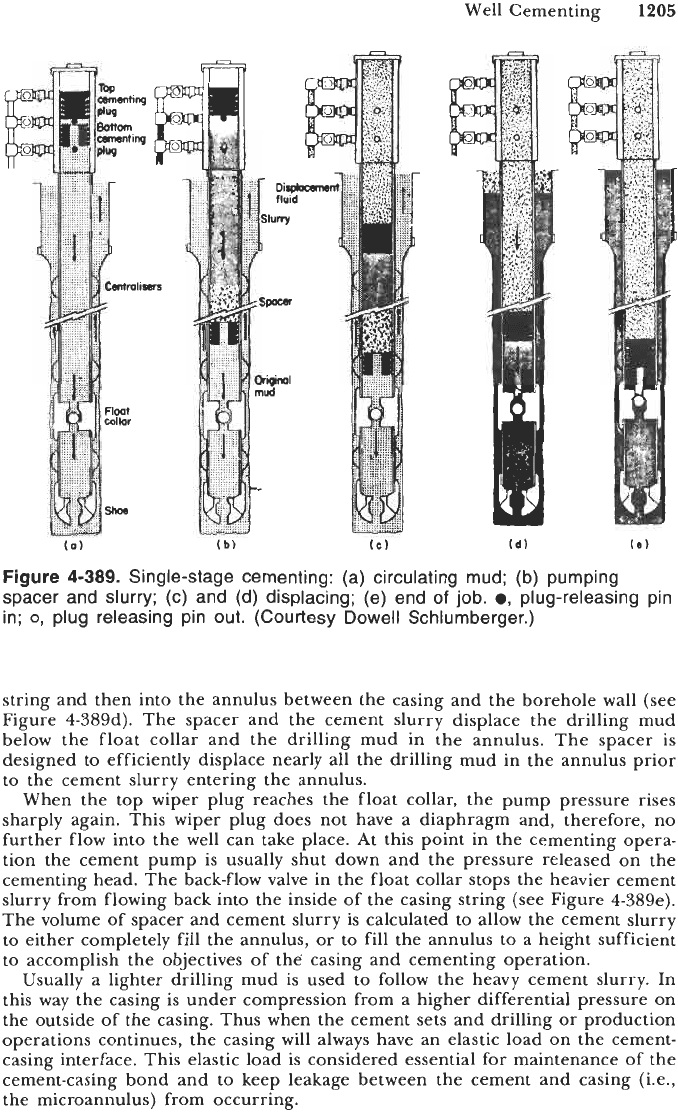
Well Cementing
1205
Figure
4-389.
Single-stage cementing: (a) circulating mud; (b) pumping
spacer and slurry; (c) and (d) displacing; (e) end
of
job.
0,
plug-releasing pin
in;
0,
plug releasing pin out. (Courtesy
Dowell
Schlumberger.)
string and then into the annulus between the casing and the borehole wall (see
Figure 4-389d). The spacer and the cement slurry displace the drilling mud
below the float collar and the drilling mud in the annulus. The spacer is
designed to efficiently displace nearly all the drilling mud in the annulus prior
to the cement slurry entering the annulus.
When the top wiper plug reaches the float collar, the pump pressure rises
sharply again. This wiper plug does not have a diaphragm and, therefore, no
further flow into the well can take place. At this point in the cementing opera-
tion the cement pump
is
usually shut down and the pressure released on the
cementing head. The back-flow valve in the float collar stops the heavier cement
slurry from flowing back into the inside of the casing string (see Figure 4-389e).
The volume of spacer and cement slurry is calculated to allow the cement slurry
to either completely fill the annulus, or to fill the annulus to a height sufficient
to accomplish the objectives of the casing and cementing operation.
Usually a lighter drilling mud is used to follow the heavy cement slurry. In
this way the casing is under compression from a higher differential pressure on
the outside of the casing. Thus when the cement sets and drilling or production
operations continues, the casing will always have an elastic load on the cement-
casing interface. This elastic load is considered essential for maintenance of the
cement-casing bond and to keep leakage between the cement and casing (i.e.,
the microannulus) from occurring.
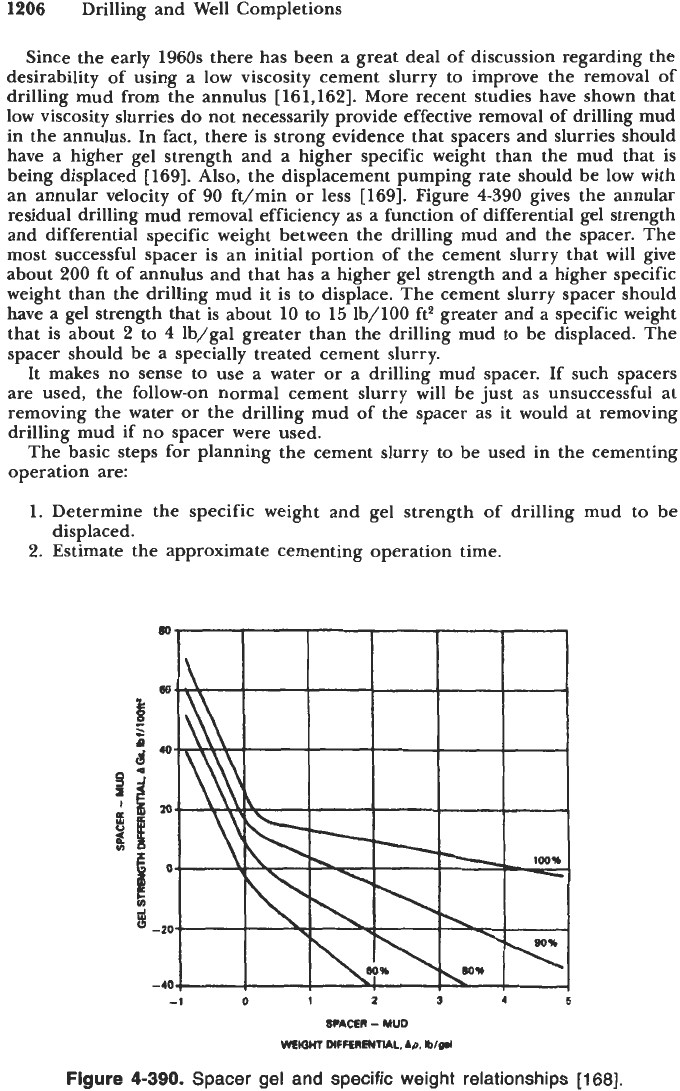
1206
Drilling and Well Completions
Since the early
1960s
there has been a great deal of discussion regarding the
desirability of using a low viscosity cement slurry to improve the removal of
drilling mud from the annulus
[161,162].
More recent studies have shown that
low viscosity slurries do not necessarily provide effective removal of drilling mud
in the annulus. In fact, there is strong evidence that spacers and slurries should
have a higher gel strength and a higher specific weight than the mud that is
being displaced
[169].
Also, the displacement pumping rate should be low with
an annular velocity of
90
ft/min or less
[169].
Figure
4-390
gives the annular
residual drilling mud removal efficiency as a function of differential gel strength
and differential specific weight between the drilling mud and the spacer. The
most successful spacer is an initial portion of the cement slurry that will give
about
200
ft of annulus and that has a higher gel strength and a higher specific
weight than the drilling mud it is to displace. The cement slurry spacer should
have a gel strength that is about
10
to
15 lb/lOO
ft* greater and a specific weight
that is about
2
to
4
lb/gal greater than the drilling mud to be displaced. The
spacer should be a specially treated cement slurry.
It makes no sense to use a water or a drilling mud spacer. If such spacers
are used, the follow-on normal cement slurry will be just as unsuccessful at
removing the water
or
the drilling mud of the spacer as it would at removing
drilling mud if no spacer were used.
The basic steps for planning the cement slurry to be used in the cementing
operation are:
1.
Determine the specific weight and gel strength of drilling mud to be
2.
Estimate the approximate cementing operation time.
displaced.
-1
0
1
2
3
5
SPACER
-
MUD
WHYn
MFRRENTIAL,
A
P.
lb/@
Figure
4-390.
Spacer gel and specific weight relationships
[168].
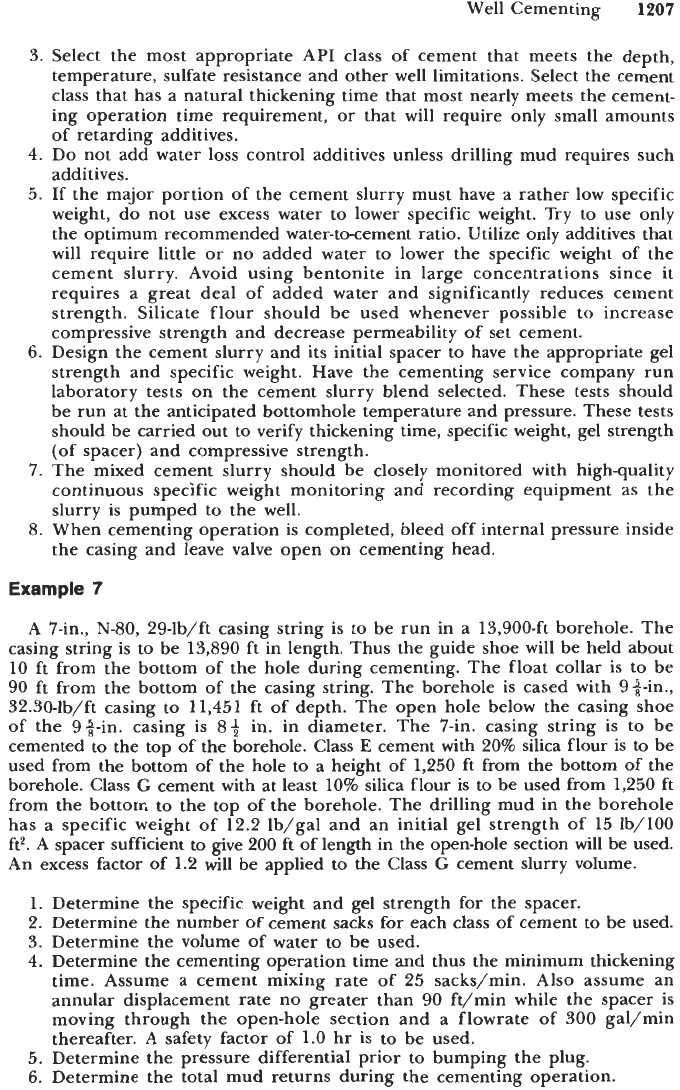
Well Cementing
1207
3. Select the most appropriate API class of cement that meets the depth,
temperature, sulfate resistance and other well limitations. Select the cement
class that has a natural thickening time that most nearly meets the cement-
ing operation time requirement, or that will require only small amounts
of retarding additives.
4.
Do not add water loss control additives unless drilling mud requires such
additives.
5.
If the major portion of the cement slurry must have a rather low specific
weight, do not use excess water to lower specific weight. Try to use only
the optimum recommended water-to-cement ratio. Utilize only additives that
will require little
or
no added water to lower the specific weight of the
cement slurry. Avoid using bentonite in large concentrations since it
requires a great deal of added water and significantly reduces cement
strength. Silicate flour should be used whenever possible to increase
compressive strength and decrease permeability
of
set cement.
6.
Design the cement slurry and its initial spacer to have the appropriate gel
strength and specific weight. Have the cementing service company run
laboratory tests on the cement slurry blend selected. These tests should
be run at the anticipated bottomhole temperature and pressure. These tests
should be carried out to verify thickening time, specific weight, gel strength
(of spacer) and compressive strength.
7. The mixed cement slurry should be closely monitored with high-quality
continuous specific weight monitoring and recording equipment as the
slurry is pumped to the well.
8.
When cementing operation is completed, bleed off internal pressure inside
the casing and leave valve open on cementing head.
Example 7
A 7-in., N-80, 29-lb/ft casing string is to be run in a 13,900-ft borehole. The
casing string is to be 13,890 ft in length. Thus the guide shoe will be held about
10 ft from the bottom of the hole during cementing. The float collar is to be
90
ft from the bottom of the casing string. The borehole is cased with gj-in.,
32.3O-lb/ft casing to 11,451 ft
of
depth. The open hole below the casing shoe
of the 9j-in. casing is 8+ in. in diameter. The 7-in. casing string is to be
cemented to the top of the borehole. Class
E
cement with 20% silica flour is to be
used from the bottom of the hole to a height of 1,250
ft
from the bottom of the
borehole. Class
G
cement with at least 10% silica flour is to be used from 1,250
ft
from the bottom to the top
of
the borehole. The drilling mud in the borehole
has a specific weight of 12.2 Ib/gal and an initial gel strength of 15 lb/lOO
ft2. A spacer sufficient to give 200 ft of length in the open-hole section will be used.
An excess factor of 1.2 will be applied to the Class
G
cement slurry volume.
1. Determine the specific weight and gel strength for the spacer.
2.
Determine the number
of
cement sacks
for
each class of cement
to
be used.
3. Determine the volume of water to be used.
4.
Determine the cementing operation time and thus the minimum thickening
time. Assume a cement mixing rate
of
25 sacks/min. Also assume an
annular displacement rate no greater than 90 ft/min while the spacer is
moving through the open-hole section and a flowrate of 300 gal/min
thereafter. A safety factor of 1.0 hr is to be used.
5. Determine the pressure differential prior to bumping the plug.
6.
Determine the total mud returns during the cementing operation.
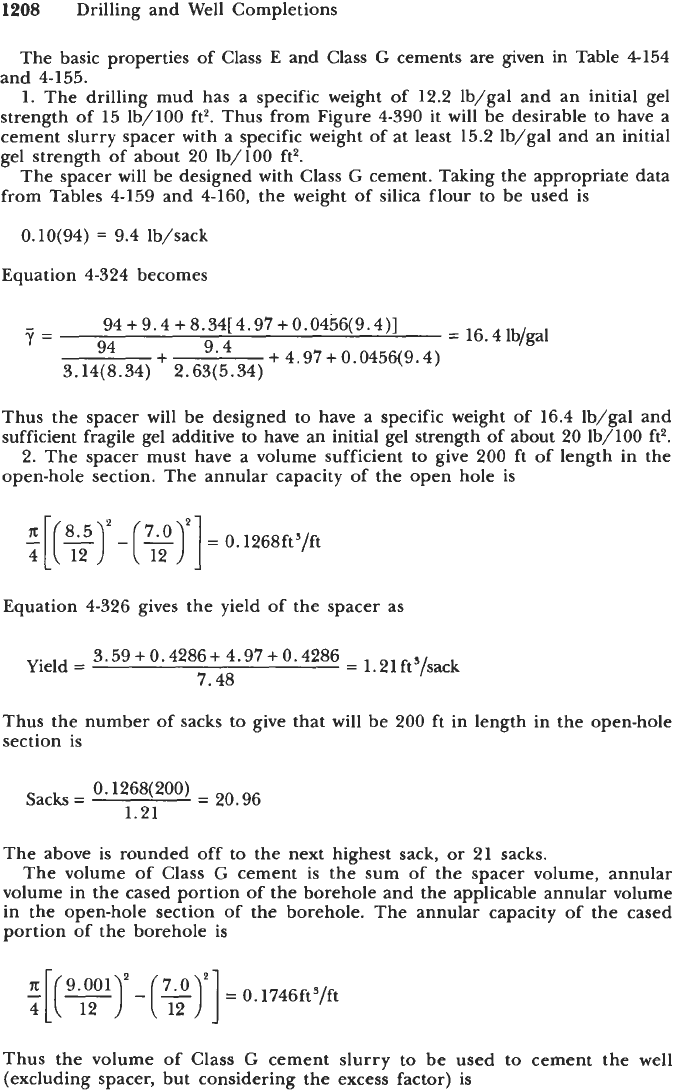
1208
Drilling and Well Completions
The basic properties of Class
E
and Class
G
cements are given in Table 4154
and 4-155.
1. The drilling mud has a specific weight of 12.2 lb/gal and an initial gel
strength of 15 lb/lOO
ft2.
Thus from Figure 4-390 it will be desirable to have a
cement slurry spacer with a specific weight of at least 15.2 lb/gal and an initial
gel strength of about 20 lb/lOO ft2.
The spacer will be designed with Class
G
cement. Taking the appropriate data
from Tables 4-159 and 4-160, the weight of silica flour to be used is
O.lO(94)
=
9.4 lb/sack
Equation 4-324 becomes
y=
94
+
9.4
+
8.34[ 4.97
+
0.0456(9.4)]
94
+
9'4
+4.97+0.0456(9.4)
=
16.
lb,pl
3.14(8.34) 2.63t5.34)
Thus the spacer will be designed to have a specific weight of 16.4 lb/gal and
sufficient fragile gel additive to have an initial gel strength of about 20 lb/lOO ft2.
2. The spacer must have a volume sufficient to give 200
ft
of length in the
open-hole section. The annular capacity of the open hole is
E[
(%I
-
(ST]
=
0.
1268fts/ft
4
Equation 4-326 gives the yield of the spacer as
3.59
+
0.4286
+
4.97
-t
0.4286
=
1.
21
ft3/sack
Yield
=
7.48
Thus the number of sacks to give that will be 200 ft in length in the open-hole
section is
0'1268(200)
=
20.96
Sacks =
1.21
The above is rounded off to the next highest sack, or 21 sacks.
The volume of Class
G
cement is the sum of the spacer volume, annular
volume in the cased portion of the borehole and the applicable annular volume
in the open-hole section of the borehole. The annular capacity of the cased
portion of the borehole
is
2
[
(yy
-
(211
=
0.
1746fts/ft
4
Thus the volume of Class
G
cement slurry
(excluding spacer, but considering the excess
to be used to cement the well
factor) is
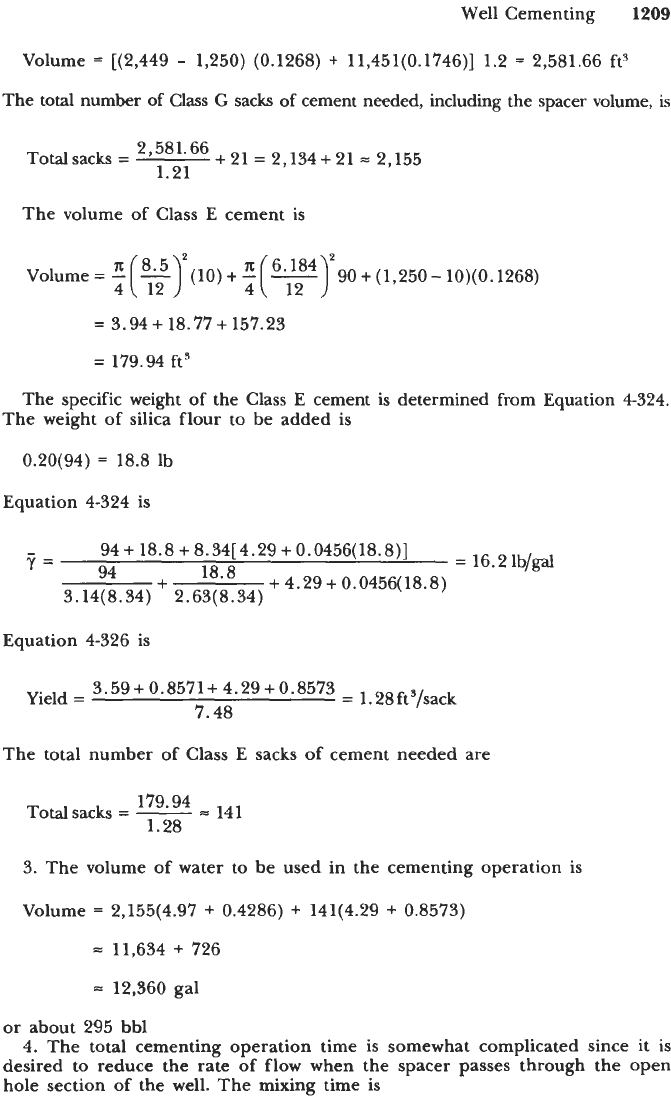
Well Cementing
1209
Volume
=
[(2,449
-
1,250) (0.1268)
+
11,451(0.1746)] 1.2
=
2,581.66
ft'
The total number of Class
G
sacks of cement needed, including the spacer volume, is
Total sacks
=
2'581'66
+21
=
2,134+21
=
2,155
1.21
The volume of Class E cement is
Volume
=
-
"(
4
-
8'5)1
12
(lo)+-
:(6~;:84)190+(1,250-10)(0.1268)
-
=
3.94
+
18.77
+
157.23
=
179.94
ft'
The specific weight of the Class E cement
is
determined from Equation
4324.
The weight of silica flour to be added is
0.20(94)
=
18.8
lb
Equation
4-324
is
94
+
18.8
+
8.34[ 4.29
+
0.0456( 18.8)]
94
+
18*8
+4.29+0.0456(18.8)
=
16.
lb,gal
?=
3.14(8.34) 2.63(8.34)
Equation
4-326
is
3.59+0.8571+ 4.29+0.8573
=
1.28fta/sack
Yield
=
7.48
The total number of Class E sacks of cement needed are
179 94
1.28
Totalsacks
=
-
=
141
3.
The volume of water to be used in the cementing operation is
Volume
=
2,155(4.97
+
0.4286)
+
141(4.29
+
0.8573)
=
11,634
+
726
=
12,360
gal
or
about
295
bbl
4.
The total cementing operation time is somewhat complicated since it is
desired to reduce the rate of flow when the spacer passes through the open
hole section
of
the well. The mixing time is
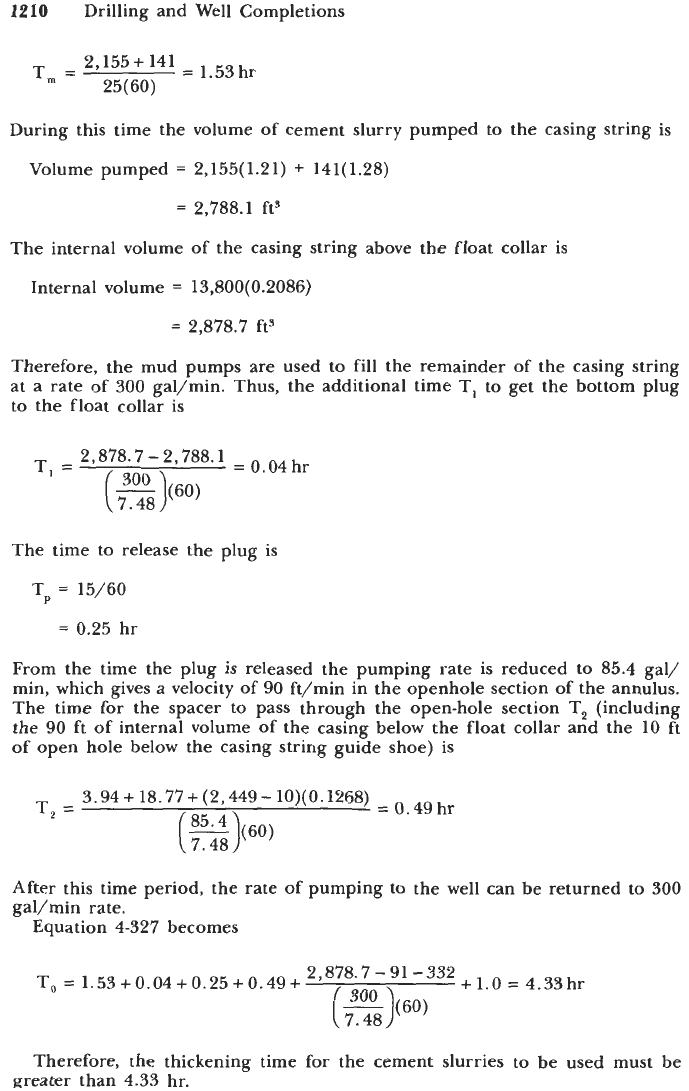
1210
Drilling and Well Completions
During this time the volume of cement slurry pumped to the casing string is
Volume pumped
=
2,155(1.21)
+
141(1.28)
=
2,788.1
ft3
The internal volume of the casing string above the float collar is
Internal volume
=
13,800(0.2086)
=
2,878.7
ft3
Therefore, the mud pumps are used to fill the remainder
of
the casing string
at a rate of
300
gal/min. Thus, the additional time
T,
to get the bottom plug
to the float collar is
2,878.7-2,788.1
=
0,04hr
T,
=
(=)(60) 7.48
The time to release the plug is
TP
=
15/60
=
0.25
hr
From the time the plug is released the pumping rate is reduced to
85.4
gal/
min, which gives a velocity of
90
ft/min in the openhole section of the annulus.
The time for the spacer
to
pass through the open-hole section T, (including
the
90
ft of internal volume of the casing below the float collar and the
10
ft
of open hole below the casing string guide shoe)
is
3.94
+
18.77
+
(2,449
-
lo)(
0.1268)
=
0,
49
hr
T,
=
7.48
After this time period, the rate of pumping to the well can be returned to
300
gal/min rate.
Equation
4-327
becomes
Therefore, the thickening time for the cement slurries to be used must be
greater than
4.33
hr.
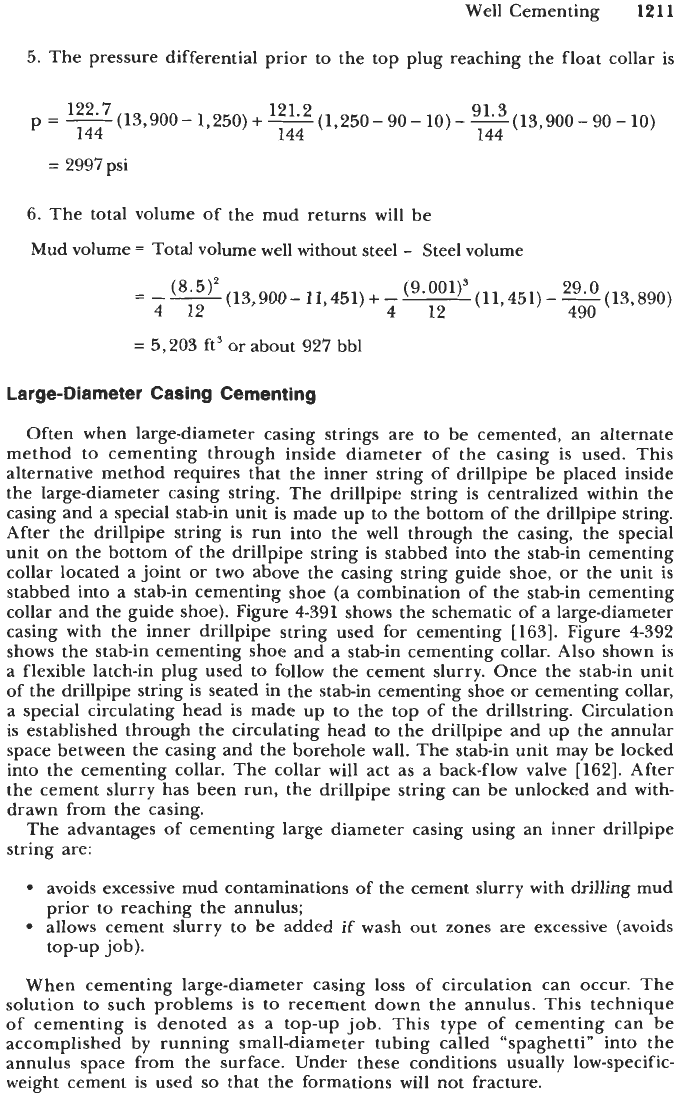
Well Cementing
1211
5.
The pressure differential prior to the top plug reaching the float collar is
(1,250
-
90
-
10)
-
=(13,900- 90
-
10)
121.2
12*”
(13,900-1,250)+-
P’144
144 144
=
2997psi
6.
The total volume of the mud returns will be
Mud volume
=
Total volume well without steel
-
Steel volume
-
--
(8.
5)2
(13,900
-
11,451)
+
-
~
(”
001)3
(1
1,451)
-
29.0
(13,890)
-
4
12 4 12 490
=
5,203
ft3 or about
927
bbl
Large-Diameter Casing Cementing
Often when large-diameter casing strings are to be cemented, an alternate
method to cementing through inside diameter of the casing is used. This
alternative method requires that the inner string of drillpipe be placed inside
the large-diameter casing string. The drillpipe string
is
centralized within the
casing and a special stab-in unit is made up to the bottom of the drillpipe string.
After the drillpipe string is run into the well through the casing, the special
unit on the bottom of the drillpipe string is stabbed into the stab-in cementing
collar located a joint or two above the casing string guide shoe, or the unit is
stabbed into a stab-in cementing shoe (a combination of the stab-in cementing
collar and the guide shoe). Figure
4-391
shows the schematic of a large-diameter
casing with the inner drillpipe string used for cementing
[163].
Figure
4-392
shows the stab-in cementing shoe and a stab-in cementing collar. Also shown is
a flexible latch-in plug used
to
follow the cement slurry. Once the stab-in unit
of the drillpipe string is seated in the stab-in cementing shoe
or
cementing collar,
a special circulating head is made up to the top of the drillstring. Circulation
is established through the circulating head to the drillpipe and up the annular
space between the casing and the borehole wall. The stab-in unit may be locked
into the cementing collar. The collar will act as a back-flow valve
[162].
After
the cement slurry has been run, the drillpipe string can be unlocked and with-
drawn from the casing.
The advantages of cementing large diameter casing using an inner drillpipe
string are:
avoids excessive mud contaminations of the cement slurry with drilling mud
prior to reaching the annulus;
allows cement slurry to be added
if
wash out zones are excessive (avoids
top-up job).
When cementing large-diameter casing
loss
of circulation can occur. The
solution to such problems is to recement down the annulus. This technique
of cementing
is
denoted as a top-up job. This type of cementing can be
accomplished by running small-diameter tubing called “spaghetti” into the
annulus space from the surface. Under these conditions usually low-specific-
weight cement is used
so
that the formations will not fracture.
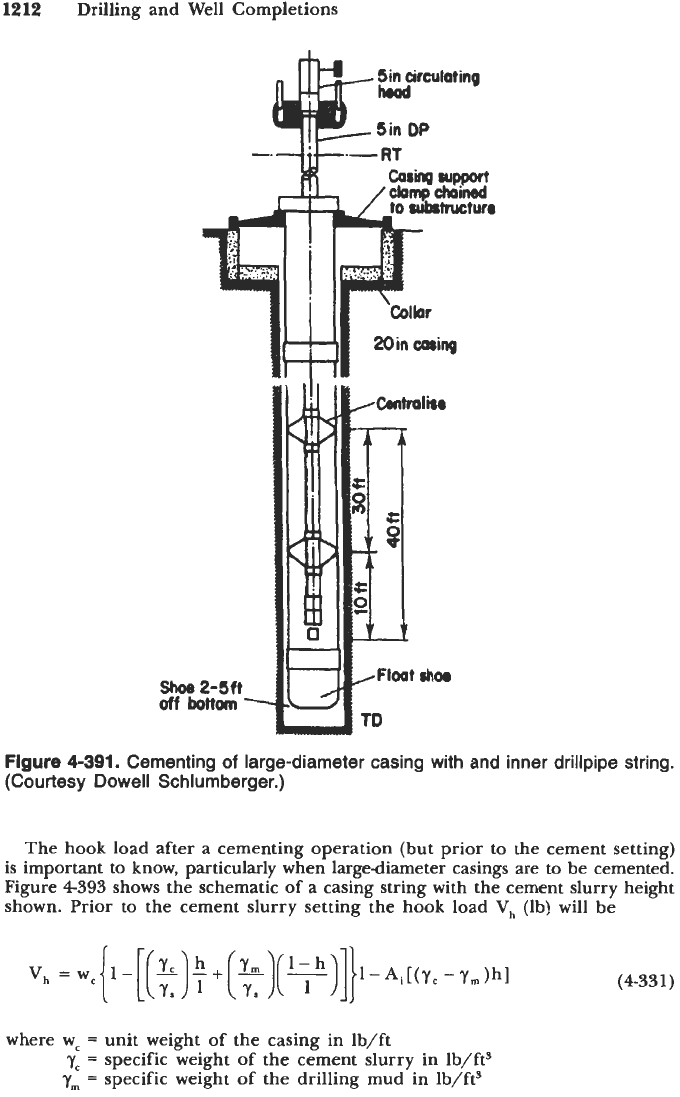
1212
Drilling and Well Completions
shoe
2-511
off
bottom
Figure
4-391.
Cementing
of
large-diameter casing with and inner drillpipe string.
(Courtesy Dowell Schlumberger.)
The hook load after a cementing operation (but prior to the cement setting)
is important to know, particularly when largediameter casings are to be cemented.
Figure
4393
shows the schematic of a casing string with the cement slurry height
shown. Prior to the cement slurry setting the hook load
V,
(lb) will be
v,
=
w,
{
1
-
[
[
?)
+
+
[
?)(
y
)]}
1
-
Ai
(Y,
-
Y,
1
hl
(4-33
1
)
where wc
=
unit weight of the casing in lb/ft
Y,
=
specific weight of the cement slurry in lb/ft3
y,
=
specific weight of the drilling mud in Ib/fts
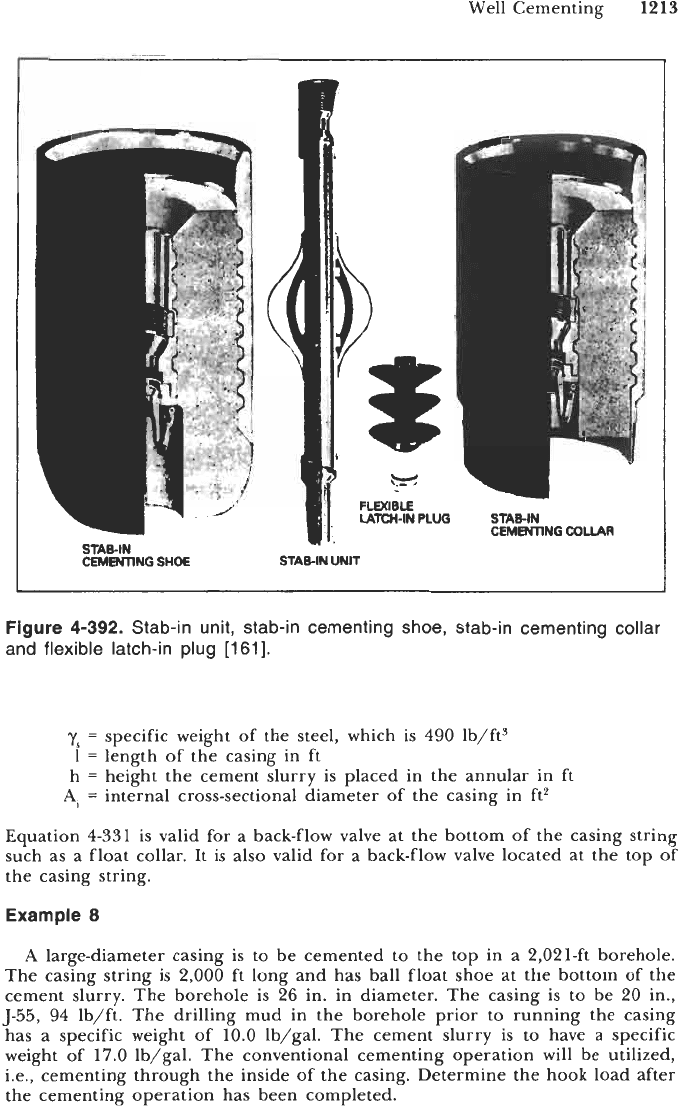
Well Cementing
1213
-
STAWN
CEMENTING
SHOE
STAEIN
CEMENTING
COWR
STAB-IN
UNIT
Figure
4-392.
Stab-in unit, stab-in cementing shoe, stab-in cementing collar
and flexible latch-in plug
[161].
y,
=
specific weight of the steel, which is
490
lb/ft3
1
=
length of the casing in
ft
h
=
height the cement slurry is placed in the annular in
ft
Ai
=
internal cross-sectional diameter of the casing in ft2
Equation
4-331
is valid for a back-flow valve at the bottom of the casing string
such as a float collar. It is also valid for a back-flow valve located at the top of
the casing string.
Example
8
A
large-diameter casing is to be cemented to the top in a 2,021-ft borehole.
The casing string
is
2,000 ft long and has ball float shoe at the bottom of the
cement slurry. The borehole is 26 in. in diameter. The casing is to be 20 in.,
5-55,
94
Ib/ft. The drilling mud in the borehole prior to running the casing
has a specific weight of
10.0
lb/gal. The cement slurry is to have a specific
weight of
17.0
lb/gal. The conventional cementing operation will be utilized,
i.e., cementing through the inside of the casing. Determine the hook load after
the cementing operation has been completed.
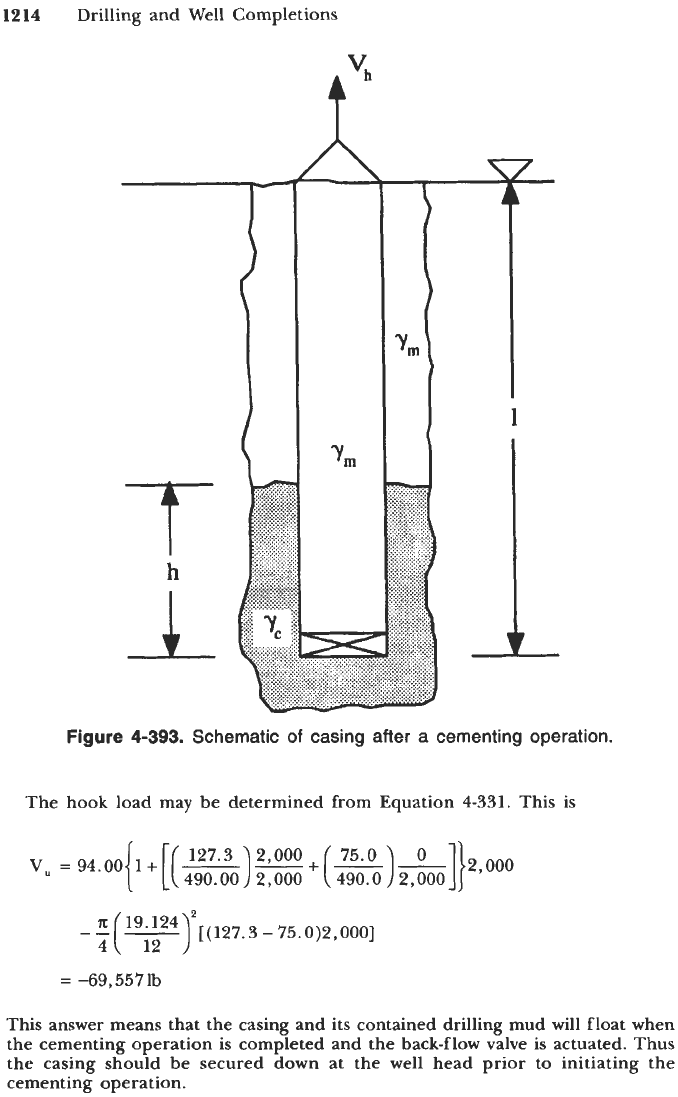
1214
Drilling and Well Completions
1
I
Figure
4-393.
Schematic
of
casing after a cementing operation.
The hook load may be determined from Equation 4-331. This is
=
-69,5571b
This answer means that the casing and its contained drilling mud will float when
the cementing operation is completed and the back-flow valve is actuated. Thus
the casing should be secured down at the well head prior to initiating the
cementing operation.
